“The Coolest Library in America”
Colby-Sawyer College has a library unique in American higher education. The following notes from our archives show how it got that way.
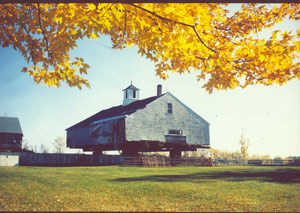
Robert Burley, F.A.I.A.
Robert Burley Associates, Waitsfield, Vermont November 22, 1980
Nicholas Muller, President, Colby-Sawyer College
Dear Nick:
This letter will summarize my impressions of the Colby-Sawyer Campus and my views on the feasibility of utilizing the adjoining Dr. Cleveland Property for library functions.
First, the central campus is a tremendous physical asset to the College in terms of both its arrangement and general appearance. New London itself is a pleasant community and the manner in which McKean-Colby-Colgate-Shepard-Austin curve away from one side of Main Street along a green forecourt, makes a very handsome entrance. Placing the academic functions around a Common, directly behind Colgate Hall, produces an understandable, workable plan…
The Cleveland Barns may be perfectly feasible for adaptation to a College Library. Because of their location at the extreme edge of the Campus, their use implies a certain commitment to expanding the entire plan in that direction…
Second, let us take a look at the barns.
In the interest of order, I will go along with Vitruvius's architectural criteria:
- FIRMNESS. There is no reason why the existing barn structural systems should not serve the purposes of a library. The storage of hay involved substantial loadings at the second floor levels. Some modifications to the structure may be required, but our experience is that they can be accomplished without detracting from either the attractiveness of the post and beam frames or the usefulness of the floor areas…
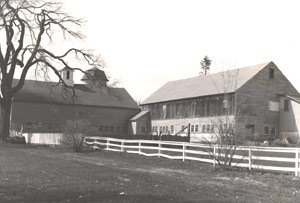 2. COMMODITY. A library in the barns would probably be a two-story concept, with occasional third-story loft areas. An elevator will be needed for both library service and handicapped users. With an elevator, a two-story scheme can be compact and efficient… Certain walls oriented to the south seem ideal for expanding the existing space and gaining a passive solar heating capability.
2. COMMODITY. A library in the barns would probably be a two-story concept, with occasional third-story loft areas. An elevator will be needed for both library service and handicapped users. With an elevator, a two-story scheme can be compact and efficient… Certain walls oriented to the south seem ideal for expanding the existing space and gaining a passive solar heating capability.
- DELIGHT. Institutions of higher learning are often strong on institutional quality and very weak on delight. Inherent in the adaptation of the barns would be a high element of delight. They are anti-institutional. If a goal of Colby-Sawyer is to become more human and less institutional, then these structures represent an opportunity that goes beyond the modest dollar-saving of recycling...
The barns offer elements of delight in addition to the obvious attraction of the heavy timber framing. Views to the southwest and southeast are exceptional; I have not walked through all of your buildings, but it is possible that there is nothing on campus to equal them...
Let me know if you have any further questions. We will hope to see you down there again.
Very truly yours,
BOB,
Robert Burley, FAIA
“Old Barn Will Become New Library at Colby-Sawyer College”
Jay Merwin, Concord Monitor, November 9, 1983
From Main Street, the old Colby Homestead barns will look much the same as when they were built, sometime before the Civil War.
 But the milking stanchions for cows will give way to new library carrels for Colby-Sawyer College students, and book stacks will replace haystacks…
But the milking stanchions for cows will give way to new library carrels for Colby-Sawyer College students, and book stacks will replace haystacks…
This spring, Colby-Sawyer will begin converting these four connected barns and sheds on the edge of campus to a new library complex….
Once known as Colby Junior, a two-year college, the institution changed its name to Colby-Sawyer in 1975, when it launched a full selection of four-year degree programs.
The changes meant expanding the curriculum, hiring more experienced faculty, adding new programs--- and overtaxing the library. Students have to stand on footstools to see books on the upper shelves of some stacks, and the college archives are piled almost to the ceiling.
During the last five years, the library collection has swelled from 40,000 to 65,000 hard-bound volumes…
“You could say we're expanding our facilities to catch up to where our programs are,” said Colby-Sawyer President H. Nicholas Muller III…
Muller is an historian who specializes in Vermont heritage. For him, commonplace items such as barns---and even fast-disappearing cabin motor court motels--- are historical artifacts worth keeping….
“Colby-Sawyer Converting Barns Into Innovative Reference Center”
Bob Percy, New Hampshire Sunday News, May 12, 1984
…Colby-Sawyer's students, 80 percent of whom are in baccalaureate programs, have a great need of more extensive collections than the students who attended Colby-Sawyer 10 years ago when it was a junior college, [President] Muller said. The college intends to increase its collection from 65,000 to 110,000 volumes.
But Muller and college trustees noted the college requires something more than a larger building in which to store books and magazines.
“We need a place which promotes learning and attracts students and keep them there,” Muller said. “We also want to make a visual impression on a casual borrower of each book….”
Muller said the college's expanding campus will be tied together by the Colby Homestead, which besides the two barns includes six acres of land, a silo and various smaller buildings.
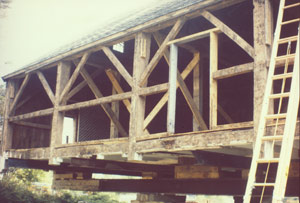 Until the college bought the homestead in 1981, it had been the property of the Colby family since the 1780s. Gov. Anthony Colby, one of the college's founders, lived there, as did his daughter Susan Colby, one of Colby-Sawyer's first academic leaders.
Until the college bought the homestead in 1981, it had been the property of the Colby family since the 1780s. Gov. Anthony Colby, one of the college's founders, lived there, as did his daughter Susan Colby, one of Colby-Sawyer's first academic leaders.
The Colby Homestead is one of New London's oldest homesteads, town archivist Mildred Tunis said. Muller said the homestead is rivaled in historic importance in the community only by the First Baptist Church.
“CSC breaks Ground”
Argus-Champion, August 15, 1984
The board of trustees of Colby-Sawyer College voted Aug. 10 to begin construction of the new Library and Learning Center at the 148-year old women's college in New London. Ground-breaking ceremonies were held outside the Cleveland Homestead barns from which the new library facility will be constructed.
The contractor Engelberth Construction, Inc., Winooksi, VT, will convert the pre-Civil War barns to an open-space, split-level research and resource center retaining the original hand-hewn timber frames in the interior and the traditional New England barn façade on the exterior…
“New College Library Will Have An Old-Fashioned Feel”
Sharon Voas, Concord Monitor, September 27, 1984
People driving by Colby-Sawyer College do double takes when they see the huge barns of the historic Colby Homestead seeming to hover 6 feet in the air. The Civil War era barns, which are jacked up on steel beams, are being converted into a new library complex for the college.
The school wants to retain as much as it can of the barns' original architectural details. That meant rolling a 60-foot barn and a 70-foot barn off their foundations last week to build basements and replace the rotted first floors. In two or three weeks the barns will be rolled onto new foundations in the same places where they have stood for 130 years…
By next July, the three barns and some new additions will become a 20,000 square foot library complex with open-bean ceilings. From outside the barns will still look much like they were when they were built, except that glass-walled reading rooms will look out on Mount Kearsarge. Event the homestead's silo will be saved and turned into a library entrance…
Because the barns have only one layer of boards and no insulation, new walls and roof will be built around the outside of the existing walls. Insulation will be put between the walls. The new walls will match the existing exterior exactly, as if each barn had a copy of itself built around it…
Library/Learning Center Tour Information
Summer 1985
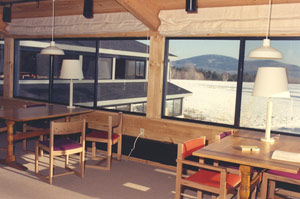 A.
A.
…The open area provides an opportunity for people to proceed down to the second person and see, up close, some of the workmanship that went into the Barns.
B.
Point out the several little doors which are open and have windows in the door space. One of the sliding doors in the corner still works and of course the large Barn door is framed but is not moveable. Point out the rough-hewn wood, particularly the new beams, all of which were rough cut and then each beam was wire-brushed to clean it and maintain the rough look. Throughout the first floor you'll notice many bolts in the beams. In all there were 2,000 bolts used at a cost of $5 per bolt.
C.
This area will be set up with tables but it will be easy to point out the main entrance, which will be through the double glass doors that are in place and, on the other side of that is the Silo. The Silo will serve as a large vestibule and entrance will be gained by walking through the Silo and then into the main part of the Library. You can point out the several open well areas, one just to the left of the Silo entrance and the other down alongside the elevator. These were done purposely to allow light and an open feeling in the basement area….
E.
Note that the large window replaced the old barn door. The door was saved and will be put on the outside to be made to look as though the door will open and will serve as shutters for the window area. Note that it is open to the second floor to allow light to come up to that area. While people are over by the window, it's easy to show them the rough wallboard which is painted white to look like whitewashed barn board- just like it was in the old barn itself.
G.
This Reading Shed has a spectacular view of Mt. Kearsarge and will be solely devoted to casual reading and study…
H.
This area obviously houses mostly stacks, does have or will have several study tables to the right of the window as you face Main Street and, of course, has one of the two rather spectacular upper level Reading Lofts above the stack areas. Point out that the old ventilation shaft which goes up to the Cupola served to take the barn odors out, particularly during the winter, and the architect incorporated that into the ventilation system…. From both positions, H and I, it is rather spectacular to look down into the Reading Shed and out into the Courtyard.
Dedication Program
Susan Colgate Cleveland Library/Learning Center, September 8, 1985
Susan Colgate Cleveland
Susan Colgate Cleveland's ties to Colby-Sawyer College extend back nearly 150 years to her great-great-grandfather Joseph Colby, one of the original incorporators of the institution. Her family also includes her great-grandfather Governor Anthony Colby, a major benefactor, and her grandmother, Susan Colby, the first principal of the school, and her aunt Miss Mary Colgate, for whom Colgate Hall is named.

Five generations of the family lived in the Colby Homestead, adjacent to the present Library/Learning Center. Mrs. Cleveland served as a Trustee of the College for 30 years and as Vice Chairman of the Board from 1957-65. Responsible for restoring the original Colby Academy building, she furnished it with many family heirlooms. She and her sister contributed the funds for building the portico on the back of Colgate Hall, and “Susan's Swamp,” a nature study area on the campus, is dedicated to her memory…
The American Institute of Architects
Donald J. Hackl, FAIA President
February 2, 1987
Loretta Kelner, Library Director Colby-Sawyer College New London, New Hampshire 03257
Dear Ms. Kelner:
It is a pleasure to inform you that the 1987 Library Buildings Award Jury, which met January 23-24, 1987, selected the Susan Colgate Cleveland Library/Learning Center for an Award of Excellence for Library Architecture. From 130 submissions, six libraries were premiated for awards.
The presentation of your award will be made during the ALA Annual Conference to be held in San Francisco on Saturday, June 27th, at the Stock Exchange Club.
Discussions of the six winning libraries by the architects and librarians and the Presentation of the awards will be held from 2:00 p.m. – 4 p.m., to be followed by a reception from 4:00 p.m. – 5:00 p.m. We sincerely hope that it will be possible for you to attend the ceremony and reception.
The release date on the awards is March 6, 1987 and we ask that you do not release information until that time.
Again, our warm congratulations.
Sincerely,
Donald J. Hackl, FAIA President
“That's Not a Barn, It's a Library”
Richard Chabourne, Wilson Library Bulletin, April 1988
When the circulation desk appears deserted, the patron simply rings a little bell--- a little cow bell. That is not without meaning. This library used to be a dairy barn.
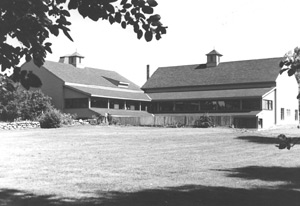
The Susan Colgate Cleveland Library-Learning Center, serving the women of Colby-Sawyer College of New London, New Hampshire, is no doubt the only library that is entered through a silo with hay forks hanging through the original barn beams overhead. It is immediately apparent why the $2.5 million facility was cited for excellence by the American Institute of Architects and the American Library Association.
The award, presented every other year by the Library Administration and Management Association, described the building as “a superb example of adaptive use at its best. A warm friendly facility that respects the integrity of the original structure while solving circulation and growing space problems."
“When the task is to preserve historical significance the challenge is usually one of maintaining the authenticity of the interior. Here we were faced with the equally important goal of retaining the exterior,” explains Robert Burley, associate of The Burley Partnership Waitsfield, Vermont, architect for the project.
More precisely, the challenge was to convert and connect to pre-Civil War diary barns to provide open, split-level research and resource areas while retaining the original hand-hewn timbers and simulating the traditional New England farm exterior…
The barns sat on the old Joseph Colby farmstead, which was immediately adjacent to the campus and was available for the college to acquire. The history of New England farming, education, and to a degree libraries can be studied in picturesque New London, where the town looks just like its postcards.
“The first barn was built in 1799 and many people in town worked on it doing individual jobs,” reports Nancy Muller, Colby-Sawyer's archivist and director of the school's sesquicentennial, explaining further that Joseph Colby also had a store, and records still exist showing that most of the barn labor was paid in bartered goods…
Even the award had its roots in New London. Emerson Greenaway, a New London resident, served as ALA president in 1957, putting in motion an award program to inspire architects to build better libraries, and to publicize the ALA…
“You have the coolest library in America”
John Baworowsky, vice president for enrollment and academic services, Saint Louis University, December 14, 2006


